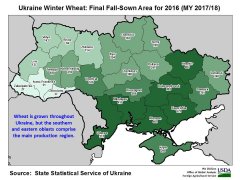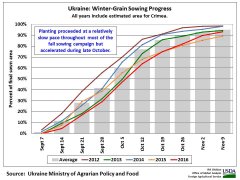Ukraine: Sown Area and Early Prospects for 2017/18 Winter Crops
 Winter wheat was planted on 6.41 million hectares (mha), up slightly from last year’s 6.29 mha, according to data from the State Statistical Committee of Ukraine (SSC). The SSC published the final fall-sown area for 2017/18 winter crops in December 2016. Winter wheat typically accounts for over 95 percent of Ukraine's total wheat area. Wheat is grown throughout Ukraine, but the southern and eastern oblasts comprise the main production region. Winter barley, which is planted in southern Ukraine and accounts for nearly 40 percent of total barley area, was sown on 1.04 mha compared to 1.13 mha last year. Rye was planted on 0.17 mha against 0.14 mha last year. Virtually all of Ukraine’s rye is winter rye. The total fall-sown area of 2017/18 winter grains is essentially unchanged from last year at 7.6 mha. Winter wheat was planted on 6.41 million hectares (mha), up slightly from last year’s 6.29 mha, according to data from the State Statistical Committee of Ukraine (SSC). The SSC published the final fall-sown area for 2017/18 winter crops in December 2016. Winter wheat typically accounts for over 95 percent of Ukraine's total wheat area. Wheat is grown throughout Ukraine, but the southern and eastern oblasts comprise the main production region. Winter barley, which is planted in southern Ukraine and accounts for nearly 40 percent of total barley area, was sown on 1.04 mha compared to 1.13 mha last year. Rye was planted on 0.17 mha against 0.14 mha last year. Virtually all of Ukraine’s rye is winter rye. The total fall-sown area of 2017/18 winter grains is essentially unchanged from last year at 7.6 mha.
The area sown to winter rape, Ukraine’s only winter oilseed crop, increased to 0.90 mha compared to only 0.42 mha planted last year when dry weather reduced sown area. Despite the substantial rebound from last year’s 10-year low, Ukraine rapeseed area has been declining since 2008 coincident with the huge increase in soybean area. (The area numbers cited above, for both grains and rapeseed, reflect the area reported by SSC plus estimated sown area in Crimea, which is not included in the SSC number.)
 The fall sowing campaign was hampered by dry weather in September followed by above-average rainfall in October, especially in southern Ukraine. The planting pace throughout most of the campaign was the slowest in at least ten years. The October rainfall that impeded planting also replenished depleted surface moisture, providing generally favorable conditions for the emergence and establishment of winter crops. Satellite-derived vegetation indices (NDVI, or normalized difference vegetation index) from early November, when planting was complete but before winter crops entered dormancy, suggest that crop establishment in Ukraine’s prime wheat production region was mixed – better than normal in some territories and worse than normal in others. The localized below-normal NDVI could be attributed in part to this season’s late planting and the resulting late emergence. The fall sowing campaign was hampered by dry weather in September followed by above-average rainfall in October, especially in southern Ukraine. The planting pace throughout most of the campaign was the slowest in at least ten years. The October rainfall that impeded planting also replenished depleted surface moisture, providing generally favorable conditions for the emergence and establishment of winter crops. Satellite-derived vegetation indices (NDVI, or normalized difference vegetation index) from early November, when planting was complete but before winter crops entered dormancy, suggest that crop establishment in Ukraine’s prime wheat production region was mixed – better than normal in some territories and worse than normal in others. The localized below-normal NDVI could be attributed in part to this season’s late planting and the resulting late emergence.
Although favorable fall establishment conditions certainly benefit winter crops and can contribute to higher potential yield, spring weather is by far the most important factor in determining final yield. Ideal spring weather can compensate for extremely poor fall establishment conditions, as was demonstrated by Ukraine’s 2016/17 wheat crop. Severe dryness in autumn 2015 curtailed winter-wheat planting and hampered emergence and establishment, as indicated in early-November NDVI. Abundant winter and spring precipitation reversed the dryness, and outstanding conditions throughout the remainder of the growing season drove wheat yield to a record 4.15 tons per hectare.
All winter crops in Ukraine currently are dormant and in generally good condition. Although temperatures plunged during a brief episode of frigid weather in early January, snow cover prevented damage to winter crops and protective snow cover remains in place throughout most of the country as of January 22. Crops typically resume vegetative growth in March, earlier in the extreme south, and harvest begins in late June. The final sown area (i.e., initial sown area minus fall and winter losses) will be reported by SSC in April, after winter grains in all areas of Ukraine have fully resumed vegetative growth and losses can be accurately determined. Initial USDA estimates of 2017/18 global crop production will be released on May 10, 2017.
The invaluable contribution of Denys Sobolev, agricultural specialist at the USDA Office of Agricultural Affairs in Kyiv, is gratefully acknowledged. Current USDA area and production estimates for grains and other agricultural commodities are available on IPAD's Agricultural Production page or at PSD Online.
Visit Crop Explorer http://www.pecad.fas.usda.gov/cropexplorer/
|

